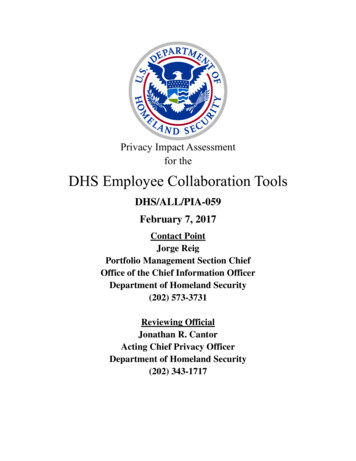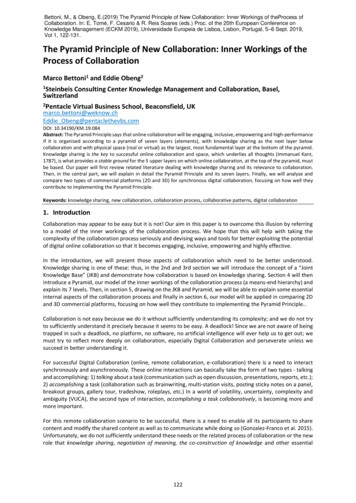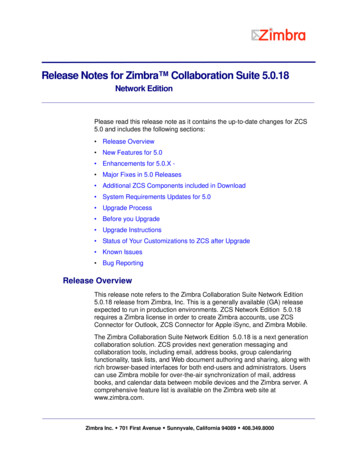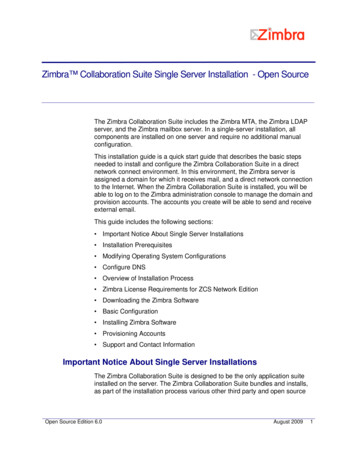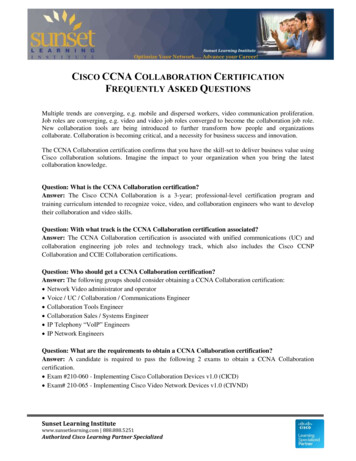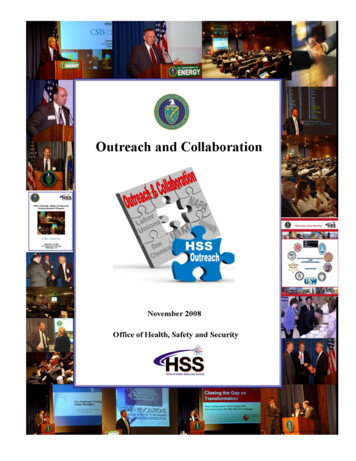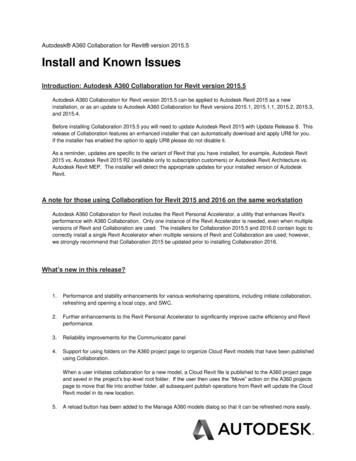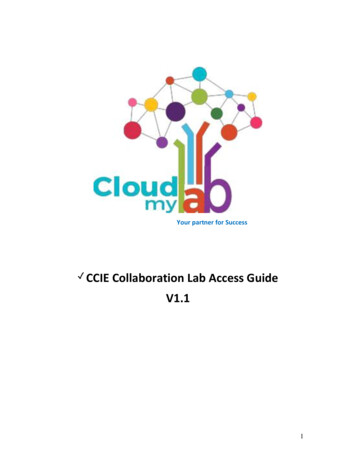
Transcription
Journal of Information Systems & Information Technology (JISIT)ISSN: 2478-0677Vol. 5 No.1 2020101-109Effective use of collaboration tools in Moodle LMS byLecturers and Students at South Eastern University of SriLankaAbdul Jabbar Mohamed HasmyDepartment of Management and Information Technology,Faculty of Management and Commerce,SouthEastern University of Sri Lanka,hasmie@seu.ac.lkAbstract. In recent years, LMS has become important integral part of Sri Lankan highereducational institutes that greatly influencing in teaching and learning activities speciallyafter the Covid-19 pandemic. There are various commercial and open source LMSsystems are available. Most of the Higher Educational Institute in Sri Lanka are usingMoodle LMS. Moodle is widely used open-source platform and it contains manyactivities and resources to support teaching and learning activities. Moodle by defaultoffers collaboration tools such as Wiki, groups, forums and many more and alsoadditional collaboration tools can be installed as external plugins. Collaboration toolsare essential for building a community of active learners and share knowledge in asystematic way. This paper attempts to study of the effective usage of collaborative toolsin Moodle by both teachers and learners. Teaching staff and students were interviewedat South Eastern University of Sri Lanka from the faculties of Management, Arts &Culture, Islamic Studies and Arabic Language and Technology. This study finds thatparticipants mainly using Moodle as an online source of teaching materials and forconducting continues assessments and that the tools for collaboration are not muchutilized. This research study also revealed that many reasons have dampened the usageand commitment of the collaborative features inside Moodle. These may be recognizedas structure and user friendliness, reaction speed and a preference for alternativetechnologies.Keywords: Moodle, Collaborative tools, Online learning, e-learning, Teaching,Learning1 IntroductionWith the rapid growth of classrooms and the technological development the demands andneeds of the Higher Educational Institutes (HEI) to capitalize on LMS for learning andteaching activities have significantly increased. There are many such LMS available withdifferent features and capabilities. Moodle, an open-source LMS has been around at most ofthe HEIs in Sri Lanka, especially after Covid-19 pandemic it has become unavoidable integralpart of HEIs. This has often been seen as an attempt for these HEIs to be more operationaland to offer teaching resources for a larger number of students. Initially the idea of using LMSwas focused on the delivery of course materials to distance and external students and provideaccess to these students [1]. University of Colombo School of Computing (UCSC)’s BITdegree program was established in this way in year 2000 is an outstanding example. However,LMS has become a key factor of the education system for many students at HEIs and an ever Faculty of Management and CommerceSouth Eastern University of Sri Lanka (SEUSL)University Park, Oluvil 32360. Sri LankaReceived: 20th Jun, 2020Revised and Accepted: 30th Jun, 2020
increasing combination of face-to-face (F2F) learning and e-learning is now developing. Thisform of delivery, referred to as blended learning, uses technological advancement to extendthe physical boundaries of the classroom, providing access to learning material and resourcesand increasing the lecturer's ability to receive feedback on learners’ progress [2]Moodle is an open-source learning management system (LMS) that was created inAustralia in 2002 and has been accessible since the 1.0 version was published in March 2011.Anyone may become a teacher or a student in a Moodle-based cooperative learningenvironment. Moodle allows learners to engage in collaborative learning activities such asforums, Wiki, vocabulary, databases, and messaging. The collaborative learning activities ofthese learners also enhance the experiences of other learners. Moodle, in example, offers avariety of methods for learners to express and share their knowledge. Moodle is also a usefulfor tracking community learning activities. Through mutual collaboration among members,learners may generate new information on their own and further improve critical thinking andflexible creative problem-solving abilities.In creating a blended learning environment, an LMS is utilized to run built-in collaborativefeatures like as forums, wiki’s and blogs. These technologies, called as web 2.0, are mostprevalent to LMSs and having the potential to allow teachers to build a community via theprobable communication that may develop. Consequently, a dynamic connection may beestablished among the usage of online collaborative tools and techniques and individuals thathas the capacity to build e-learning societies [3].This article will explain and evaluate the usage of collaborative resources in an effort todiscover the benefits of utilizing LMS collaboration capabilities to build a collaborativecommunity. This study focuses on the collaborative capabilities that come standard with theMoodle LMS, which was utilized at the institution where the research was conducted.2 Collaborative Tools and Blended Teaching & LearningThe application of digital technology encourages collaboration in blended learning contexts.Generally speaking, the main trend in the current higher education is a blended method whichmixes the conventional approach to the classroom with a digital approach. Different researchthat examine the difference between mixed learning methods and practices examine thevariations in the blended mode[4]. Various technologies and resources are utilized to promoteinteraction amongst students through a comprehensive strategy, including recordedclass video, portfolios, online tutorials, wikis and online discussion[5].The Moodle LMS has been developed to allow teachers to build online courses thatencourage students' involvement in an interactive and collaborative environment. The primarygoal of Moodle is to assist the instructors to offer better chances to convey the informationand for support in gaining knowledge, skills, and experiences. Moodle plays a key role inoffering flexibility to meet students' needs, engagement, and incentives [6], [7]. Because thestructure of the classroom teaching environment is not regarded as an interactive setting thatencourages active involvement and engagement, improving student engagement in highereducation is regarded as a recurring issue.LMSs at universities offer lecturers with a platform that includes built-in collaborationcapabilities (such as blogs, wikis and forums) for use in their instructional activities. Whenthese technologies are utilized in conjunction with traditional class setup, the concept ofblended learning can be used. In the higher education industry, a commonly used LMS suchas Moodle is often used to comprehend this idea of blended learning [8].The Moodle community website includes examples that illustrate the potentialadvantages of using the Moodle LMS in higher education. The University of Colombo School102
of Computing (UCSC) [9] UCSC has been utilizing Moodle since 1999 and uses its VirtualLearning Environment (VLE) to provide learning materials and all course related notificationsfor the Bachelor of Information Technology (BIT) degree program. Despite the large numberof individuals who use Moodle, Heaton et al [10] stated that learning materials and courserelated announcements are the most sought aspects of Moodle by lectures and students, notcollaborative functions. Although literature highlights the major importance of thesetechnologies, further study [11] shows a much lesser active engagement with these tools byteaching staff and students in the Moodle classroom.Beckman, Scott, and Wymore (2018) suggest in their study that collaboration offers arange of experiences for pupils and balances openness and reluctance to change [14].Collaboration also promotes the capacity to link the knowledge of each student. As such,cooperation may be considered to contribute to giving students with a range of experiencesand linking various kinds of knowledge. However, students don't have too many chances toparticipate in highly collaborative activities. In particular, for university students,collaborative activities that take a lot of time leads to increased learning goals are not oftenutilized as teaching techniques. As online learning is being reinforced, it is essential todiscover methods to improve collaborative activities via online learning.Greenagel[15] state that the growth of collaborative tools that disregard styles of learningcould be critical aspect of the inability to engage lecturers and students in using such tools,while Everson state [16] that the interface design and user-friendliness need to be addressed.By utilizing Moodle collaborative tools and technologies blended learning environmentcan be enhanced in to a greater extend. Recent study shows the difficulties that educators arefacing within universities in dynamically utilizing Moodle collaboration tools successfully.Accordingly, the following research provided on here examines the usage of collaborationtools inside Moodle at South Eastern University of Sri Lanka(SEUSL) that promotes blendedlearning in all course related activities throughout all faculties.3 Research Design3.1 Objectives of the researchThe primary aim of this research was to examine how collaborative tools are being utilizedinside Moodle LMS for teaching and learning at SEUSL, and to identify the variables thataffect their successful use. Moodle is a typical open-source LMS utilized for a duration ofeight years in the university.3.2 MethodologyThe research was carried out using both quantitative and qualitative methodologies. Utilizingboth methods at the same time, it renders a complete picture of the issue and offers a‘comprehensive study of the research challenge’ [17]. Open-ended interviews were performedwith participants (teachers & students) and usage data relating to the use of collaborative toolsin Moodle were gathered and evaluated. The open-ended interviews offer more significantinformation being produced by enabling respondents to convey their own perceptions usingtheir own phrases [18], while the combined use data provide a more holistic picture of theresearch.3.3 Participants of the research103
Both academic staff and students are the participants of this research who were selected fromthe faculties of Management, Arts and Culture, Islamic Studies and Technology and allstudying at SEUSL where the study was performed. The participants were notified about theresearch and they individually contributed and provided complete permission to take part inthe study. Participants were carefully selected to different gender, age and jkowledge.3.4 Conducting InterviewsInterviews were fixated on the various ways that the participants utilize the collaborativefeatures of Moodle with open ended questions. When no new data was obtained fromparticipants, the number of people questioned was reduced when a saturation level wasachieved. Guest[19] showed that saturation typically happens during the first thirty interviewsand this is adequate to get a valid result. Total number of 127 participant were contributed tothe research.4 Findings and DiscussionThe responses and the statistics on usage of the collaborative tools were the two main sourcesof data. The results in both of these categories will be shown in this section.4.1 Conducting InterviewsAccording to the responses collected in interview, 23 percent of the lecturers questioned usedcollaboration tools inside Moodle, while 39 percent of the students asked said they usedcollaborative tools for learning process. Furthermore, many students who had utilized thesetools did so just on a few times, if at all. Given that the study's goal was to find out the factorsinfluencing the usage of collaborative tools inside Moodle at SEUSL, the research findingsfocused on students and lecturers who didn’t effectively make use of the collaboration tools.An examination of the interview answers on the reasons affecting why they did not utilizecollaboration features in Moodle could be split into six main groups: interface design and userfriendliness, time constraints, alternative tools, unawareness about tools, pedagogical culture,and response time. The parts that follow give a description of the findings and analysis.4.1.1 Interface Design and User FriendlinessThe design of interface and user-friendliness of collaborative tools inside Moodle are thefactors for the failure of collaborative tools. More than two-thirds of student (65.37percent ) stated that this was a problem whereas 63 percent of lecturers also considereddesign of interface and user-friendliness to concern. Design of interface and userfriendliness linked to how easy for participants to quickly access and locate features andutilize the collaboration tools. Common opinion from students is that the Moodle is toughto browse and it isn’t user-friendly and also lecturers discovered complex processes arerequired to be done.4.1.2 Time ConstraintsTwenty-three percentage student and fifty eight percent of lecturers think that timeavailability prevents them from using collaborative tools. Students have not much time104
to try out these collaborative tool as they have to complete other course works. Lectureralso think that they have to spend considerable amount of time in preparing and arrangingcontents with such tools4.1.3 Alternative technologyA choice for alternative technology that students (49.5 percent) already engaged inhighlighted is another element of the student usage of collaboration in Moodle. Studentsexpressed a choice for alternative technologies such as WhatsApp or Google Meet forlesson relevant conversation more efficiently and quickly. They also stated that thisalternative tool includes numerous capabilities, 51 percent of lecturers expressed apreference for other collaboration tools.4.1.4 Unawareness about Collaborative ToolsUnawareness of the availability of various collaborative tools inside Moodle was notedas another issue influencing usage of such tools. This is a reason stated by 46.2 percentof students & 75 percent of educators. Many students consider Moodle as simply a meansof accessing instructional contents and get alerts.4.1.5 Pedagogical CultureHalf (50%) of the lecturers seen that the pedagogical culture as a barrier to the use ofcollaborative technology in their classes. Teachers also said that they satisfied inusing current techniques and that transitioning to alternative technology was difficulttask. Alexander and Boud [12] take a similar perspective, arguing these tools aren’tutilized in full capacity and practical teaching techniques have considered as a componentof online environment.4.1.6 Response TimeThe length of time taken for participants must wait for a response while using Moodle'sasynchronous collaborative features is referred to as response time. This was the reasonthat 48% of university students didn’t use any tools. This validates that the findings ofother studies [21] that show that a lengthy answer or no answer discourages students fromusing Moodle's collaborative capabilities.4.2 Statistical Usage DataQualitative data collected by conducting interviews for this research identified reasons relatedto users’ ability to utilize such tools in Moodle LMS. Figure 1 show the average time spentwith Moodle by students in entire university and further verified that Moodle is primarilyutilized as an web portal for teaching materials (Figure 2).105
Figure 1: User engagementFigure 1 illustrates the faculty user involvement in Moodle for a semester. Given userinvolvement doesn’t compare between a user reading and watching learning materials orproducing resources and the usage of collaboration technologies. Visits shorter than 40seconds were discarded since this is regarded as very short a period to suggest a cooperationeffort.% of 64202014 1 2014 2 2015 1 2015 2 2016 1 2016 2 2017 1 2017 2 2018 1 2018 2Figure 2: Percentage of courses that use at least one collaborative toolFigure 2 shows the proportion of units that utilized Moodle collaboration features in theinstitution. These data are collected over a five year period for each teaching semester andshow that 10 percent or fewer of the units taught at the institution utilize some kind ofcollaborative tools.The data provided in Figure 2 shows a low proportion of units utilizing Moodle collaborativefeatures. These findings further corroborate and validate the results of earlier research [22;10] and views that Moodle is utilized primarily as a delivery of contents and never exploitedin full capacity.106
Both two thirds of students and lectures stated that unpleasant user experience is the mostsignificant factor leading to the lack of utilization of the collaborative capabilities in Moodle.The second issue identified for all participants was related to knowledge of existence of theavailable collaboration tools, thirdly time restriction for lecturers and reaction time forstudents. While literature[3] explains the importance of using these tools for collaborativelearning, it is evidenced in this study that there would be 10 percent or less units in theuniversity to create these learning communities within Moodle, due to the lack of participanteffectively using collaborative tools5 ConclusionThe necessity of e-learning and LMS is increasing over the time in HEIs for teaching andlearning, but it is extremely essential that it must be utilized to promote and support goodlearning experiences for students and instructors. The sheer availability of collaborativefeatures in an LMS such as Moodle doesn’t inevitably translate to their being utilized forteaching objectives. The study confirms the necessity to address the main issues that serve asobstacles to the usage of collaborative tools in HEIs. It emphasizes the necessity to developcomputer assisted collaboration tools that promote student engagement to generatecollaborative knowledge creation via communities of practice. The success of collaborationtool in LMS such as Moodle is largely dependent on the pleasant user experience which canbe accomplished excellent user-friendly interface and greater functionality.References[1]Mason, Robin. "The university–current challenges and opportunities." D’Antoni,S.(2006). The Virtual University. Models and Messages, UNESCO-IIEP (2006).[2]Klein, Howard J., Raymond A. Noe, and Chongwei Wang. "Motivation to learnand course outcomes: The impact of delivery mode, learning goal orientation, andperceived barriers and enablers." Personnel psychology 59.3 (2006): 665-702.[3]Brown, Ann L., and Joseph C. Campione. "Communities of learning and thinking,or a context by any other name." Contemporary issues in teaching andlearning (2002): 120-126.[4]S. Eagleton, Designing blended learning interventions for the 21st centurystudent,'' Adv. Physiol. Educ., vol. 41, no. 2, pp. 203 211, Jun. 2017. doi:10.1152/advan.00149.2016.[5]Luo, Li, et al. "Blended learning with Moodle in medical statistics: an assessmentof knowledge, attitudes and practices relating to e-learning." BMC medicaleducation 17.1 (2017): 1-8.[6]Amandu, Gerald Matua, Joshua Kanaabi Muliira, and Dennis Cayaban Fronda."Using moodle e-learning platform to foster student self-directed learning:Experiences with utilization of the software in undergraduate nursing courses in aMiddle Eastern university." Procedia-Social and Behavioral Sciences 93 (2013):677-683.107
[7]L. Çelik, Evaluation of the views of pre-service teachers taught with Moodleduring the course named 'instructional technology and material design' on the useof teaching materials,'' Procedia-Social Behav. Sci.,vol. 9, pp. 1793 1797, Jan.2011. doi: 10.1016/j.sbspro.2010.12.402.[8]Pishva, D., G. G. D. Nishantha, and H. A. Dang. "A survey on how Blackboard isassisting educational institutions around the world and the future trends." 2010 The12th International Conference on Advanced Communication Technology(ICACT). Vol. 2. IEEE, 2010.[9]Andersson, A., & Hatakka, M. (2010). Increasing interactivity in distanceeducations: Case studies Bangladesh and Sri Lanka. Information Technology forDevelopment, 16(1), 16-33.[10]Heaton‐Shrestha, Celayne, et al. "Learning and e‐learning in HE: the relationshipbetween student learning style and VLE use." Research Papers in Education 22.4(2007): 443-464.[11]Green, Sue M., et al. "The development and evaluation of the use of a virtuallearning environment (Blackboard 5) to support the learning of pre-qualifyingnursing students undertaking a human anatomy and physiology module." Nurseeducation today 26.5 (2006): 388-395.[12]Alexander, Shirley, and David Boud. "Learners still learn from experience whenonline." Teaching & Learning Online. Routledge, 2018. 3-15.[13]Guri-Rosenblit, Sarah. "Eight paradoxes in the implementation process of elearning in higher education." Distances et savoirs 4.2 (2006): 155-179.[14]Beckman, S.; Scott, S.J.;Wymore, L. Collaborative Innovation: Exploring theIntersections among Theater, Art and Business in the Classroom. J. Open Innov.Technol. Mark. Complex. 2018, 4, 52.[15]Greenagel, Frank L. "The Illusion of e-Learning: Why We Are Missing Out on thePromise of Technolo." E-learning (2002).[16]Everson, Michelle. "10 ThingsOnline." Elearn 2009.9 (2009).[17]Creswell, John W., and J. David Creswell. Research design: Qualitative,quantitative, and mixed methods approaches. Sage publications, 2017.[18]Tashakkori, Abbas. Foundations of mixed methods research: integratingquantitative and qualitative techniques in the social and behavioral sciences. SagePublications, 2009.[19]Guest, Greg, Arwen Bunce, and Laura Johnson. "How many interviews areenough? An experiment with data saturation and variability." Field methods 18.1(2006): 59-82.I'veLearnedAboutTeaching108
[20]Bradford, Peter, et al. "The Blackboard learning system: The be all and end all ineducational instruction?." Journal of Educational Technology Systems 35.3(2007): 301-314.[21]Jones, Norah, et al. "Get out of MySpace!." Computers & Education 54.3 (2010):776-782.[22]Green, Sue M., et al. "The development and evaluation of the use of a virtuallearning environment (Blackboard 5) to support the learning of pre-qualifyingnursing students undertaking a human anatomy and physiology module." Nurseeducation today 26.5 (2006): 388-395.109
Furthermore, many students who had utilized these tools did so just on a few times, if at all. Given that the study's goal was to find out the factors influencing the usage of collaborative tools inside Moodle at SEUSL, the research findings focused on students and lecturers who didn't effectively make use of the collaboration tools.
